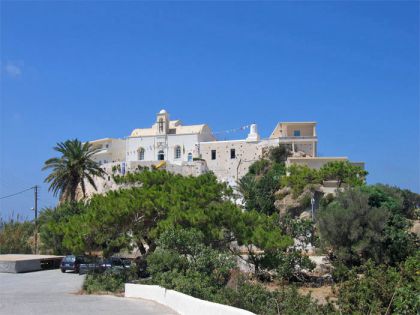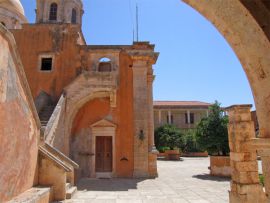-
Agia Triada, Akrotiri
 The Agia Triada (Holy Trinity) monastery is located in the northwest part of the Akrotiri peninsula, 16 km from Chania, and it is placed in the green. Although the community decreases the old buildings are gradually restored and the monastery is still active with an excellent library. All the visitors are welcomed and you can buy traditional olive oil from the monks.
The Agia Triada (Holy Trinity) monastery is located in the northwest part of the Akrotiri peninsula, 16 km from Chania, and it is placed in the green. Although the community decreases the old buildings are gradually restored and the monastery is still active with an excellent library. All the visitors are welcomed and you can buy traditional olive oil from the monks.
The Agia Triada monastery was built in the seventeenth century on top of a pre-existing church according to the Byzantine cruciform architecture with three domes. It was founded by the Venetian monks Jeremiah and Laurentio Giancarolo who were converts to the Orthodox faith. The main church is dedicated to the Agia Triada and the two side chapels to Agios Ioannis Prodromos and to Zoodocho Pighi (Source of Life).
The facade of the church has double columns of Ionic and Corinthian style and an inscription. The monastery's museum has manuscripts and important portable icons from the 15th, 16th, 17th and subsequent centuries. In the Agia Triada Monastery was a religious school in the 19th century.
The approach to the Monastery is really impressive through an amazing landscape of olive trees and grapevines as well a stand in cypresses trees (Tel: 0030 28210 63310).
-
Gouverneto, Akrotiri
 The Gouverneto monastery is located 5 km north of the Agia Triada monastery, deep in the wild and bareen Akrotiri peninsula.
The Gouverneto monastery is located 5 km north of the Agia Triada monastery, deep in the wild and bareen Akrotiri peninsula.
It is a fortress-type complex with a square tower on each of its four corners. The rectangular courtyard is dominated by a dome church dedicated to the virgin with an ornate sculptured Venetian facade. In the chapel in the small courtyard of the Moni Gouverneto there are some of the oldest frescoes in Crete (Tel: 0030 28430 63319).
The Holy Monastery of Gouverneto is open every Monday, Tuesday and Thursday from 9:00 to 12:00 and from 17:00 to 19:00. Every Saturday and Sunday it opens from 5:00 to 11:00 and from 17:00 to 20:00.
-
Katholiko, Akrotiri
 The Katholiko monastery is the most ancient moni in Crete, dating back to the 11th century. The monastery became a place of formal worship in the thirteenth century. About three hundred years ago, the monks abandoned the monastery because of persistent pirate raids.
The Katholiko monastery is the most ancient moni in Crete, dating back to the 11th century. The monastery became a place of formal worship in the thirteenth century. About three hundred years ago, the monks abandoned the monastery because of persistent pirate raids.
The Katholiko monastery, built into the sides of a ravine, contains a church dedicated to Agios Ioannis Xenos, or St. John the Hermit, the founder of the monastery, who lived and died in the nearby cave that bears his name. The church itself is carved into the rock of the mountain side, and its facade lines up with the slope of the mountain. The bridge across the ravine, and some buildings of the old monastery are still preserved. The view is amazing.
The photos are from the cave in which St Ioannis the Hermit is said to have lived and died - a large, dank and dripping cave with stalagmites and stalactites. The ruins nearby exhibit a Minoan shrine, which had become a sanctuary dedicated to the goddess Artemis during the Greek period.
It takes 20 minutes to reach the cave if you follow the path starting from the Gouverneto Monastery; it takes 15 more minutes to reach the Katholiko monastery.
-
Gonia, Kolymbari
 Gonia Monastery is located 1 km from the village of Kolymbari. Today dedicated to the Assumption of the Virgin (feast day: August 15), the monastery was originally founded in the 9th century and was originally dedicated to Aghios Georghios. It was rebuilt during the 17th century in a wonderful place, it is surrounded by verdant vegetation and it offers a magnificent view.
Gonia Monastery is located 1 km from the village of Kolymbari. Today dedicated to the Assumption of the Virgin (feast day: August 15), the monastery was originally founded in the 9th century and was originally dedicated to Aghios Georghios. It was rebuilt during the 17th century in a wonderful place, it is surrounded by verdant vegetation and it offers a magnificent view.
The monastery has a fortress form, overlooking the bay in front of it; it was also a centre of resistance during the revolution of 1821.
Gonia Monastery hosts today an important collection of precious post-Byzantine icons, relics, and other rare religious treasures. The Orthodox Academy of Crete is located next to the Gonia Monastery.
-
Chrissoskalitissa, Elafonisi
 Built up on rocks some 35 metres high, 3 km from the famous area of Elafonisi, it overlooks the Libyan Sea. According to Cretan tradition, the name of the monastery is derived from one of the ninety steps which lead there, which is said to be golden ("chryso" in Greek).
Built up on rocks some 35 metres high, 3 km from the famous area of Elafonisi, it overlooks the Libyan Sea. According to Cretan tradition, the name of the monastery is derived from one of the ninety steps which lead there, which is said to be golden ("chryso" in Greek).
According to the monks one of the 90 steps was hollow and it was used to hide the treasure of the Monastery, hence the name. It was used to pay the taxes imposed by the Ottoman rulers.
It is one thousand years old and it may have been built on the site of a Minoan temple. Chrissoskalitissa means 'golden staircase'.








